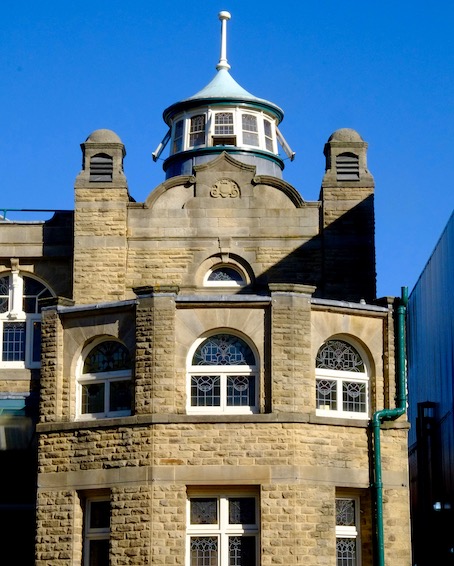Harrogate’s Royal Hall, my third striking skyline structure in the Yorkshire spa town, actually has three towers topping its entrance front, a rather squat square one in the middle and two round ones, one at each end. I like the design of the circular end towers – they’re actually quite plain, but the ring of windows offers ventilation, light – and, presumably, could be illuminated at night too, to add interest to the evening skyline.
This large building fulfilled several functions, as hinted by its original name, still carved into the face: Kursaal. If you look up the word ‘kursaal’ in a dictionary, you’ll find it defined as ‘a public room at a spa’. The word comes from the German, and is made up of words for ‘cure’ and ‘hall’. But curative functions were far form the only ones in most kursaals – balls, entertainments, theatrical performances, those were the kinds of things that might take place there, and today buildings known as kursaals are given over to all kinds of uses, cinemas and theatres being the most common, although the most famous kursaal, the one at Southend-on-Sea, is the main building of an amusement park and was designed to house a range of activities from balls to billiards.
The Kursaal at Harrogate houses a large theatre and performance auditorium. This is surrounded by an ambulatory, a space around which people could stroll and socialise, not the least important function of the building. You could also take the waters here. This multitude of functions, and the building’s size, made it an important one for Harrogate when it was erected in 1903. A competition was organised to find the best design, and well known theatrical architect Frank Matcham was hired to assess the entries and act as consulting architect. He chose a design by an architect called Robert Beale. However, the council judged that Beale’s design wasn’t entirely practical – it couldn’t be built with the available budget – and Matcham was asked to revise the designs. It’s said that the final result owes more to Matcham than Beale.
Matcham is best known for his theatre interiors, which are typically highly ornate and admirably practical. The Royal Hall is certainly both of those things – its highly decorative auditorium is looking good after a lengthy restoration in 2000–2008, and its entrance front is certainly inviting and striking. Like my other Harrogate towers, those of the Royal Hall pinpoint a building that’s both interesting to look at and an asset to the town.





1 comment:
This is the best Harrogate tower yet: probably it's the stone and the Baroque detail that do it! I remember reading in an old Encyclopedia Britannica that the most fashionable style then was a mixture of styles, eclectic if you like. With the rusticated blocks and Baroque-like curlicues, perhaps the building is trying to say different things at the same time: the rustication (or leaving a pecked surface) seems to have become mandatory: it's a way I date railway architecture masonry on abandoned railway lines - the smoother the older. If the stone was machine-sawed, was there a machine for rusticating?
Post a Comment